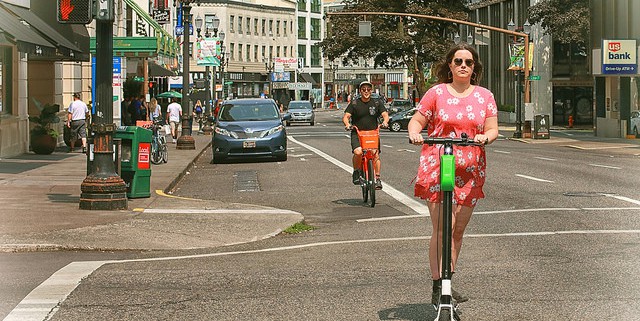Eight Essential Elements for Regulating Shared Mobility Programs
Eight Essential Elements for Regulating Shared Mobility Programs
Dockless shared mobility systems offer the potential to revolutionize sustainable transportation options in California. While we of course favor bicycles as a tried and tested, healthy, affordable, accessible, and joyful means of transportation, we welcome the exciting new developments in sustainable and active transportation technology rolling out all across our state along with dockless and docked bike share programs. California is often at the forefront of developing new technology and paradigms around mobility—and as a state we should be at the forefront of ensuring the adoption of new technology and the implementation of new systems are safe and equitable for all Californians.
In order to take advantage of this potential to provide healthy and affordable mobility options for millions for Californians living in underserved neighborhoods with few transportation options, the California Bicycle Coalition recommends the following policies.
- Ensure public priorities by enforcing permit requirements.
Cities should take advantage of state law allowing them to impose permit requirements on privately-owned fleets of shared mobility devices, such as bike share bikes. Fees to help pay for administration and enforcement of permit requirements should not be so high as to deter expansion of shared and any revenue above cost recovery should subsidize shared mobility use by low-income people. - Demand safety.
The safety of all road users, especially the most vulnerable, should be the chief and guiding principle in adoption, implementation, and analysis of any shared mobility program. The first condition of a permit is the most important, and should be taken for granted by the companies themselves: that the devices are designed to operate safely and maintained in safe operating condition. - Require appropriate parking and storage of the devices when not in use.
The permit should require that devices be parked in a location out of the way of the pedestrian path of travel. The company should educate its users on proper storage of the devices and be penalized if that education proves ineffective in some measurable way. Do not require bikes to be locked to a rack or sign. Many systems don’t provide locks capable of being locked to a pole, so such a requirement would essentially prohibit those systems. Plus, racks and secure poles are not necessarily available where the user may want to park, especially in low-income neighborhoods with poor infrastructure. - Mandate equitable pricing and access.
Health care, housing, and some transit systems have discounts for low-income users. Shared mobility systems should, too. San Francisco provides a good example, where the city’s electric dockless bike share system gives residents who qualify for certain other low-income discounts the option of a $5 annual membership. Furthermore, access to shared mobility devices like bikes and scooters should be available to people without requiring them to use prohibitively expensive smart devices, apps, or cellular data, for example by employing SMS text-based access codes or a smart card transit pass. - Mandate sufficient and equitable distribution.
This requirement is most relevant to dock-based systems, where the decision to locate docks determines which neighborhoods get service. However, even dockless systems require some “re-balancing” to ensure that devices are available in the neighborhoods in sufficient number to meet demand. A permit should require periodic evaluation of the distribution and overall supply of bikes and other devices to ensure that units are available in all neighborhoods of the service area. It might be advisable to set minimum levels of service that must be provided in order to ensure sufficient distribution. Do not set maximum limits on the number of devices allowed. - Limit the number of operators.
While the number of devices should be not be limited by permit, the number of operators should be. Too many operators can be confusing for the user and inefficient for the public if it’s not easy to use a shared mobility device from any system. - Require sufficient, culturally competent public outreach and customer service.
Information about the system should be readily available in multiple languages and formats to maximize accessibility for all Californians. Passive forms of outreach should be supplemented by more direct outreach, especially to low-income communities and communities of color. Permitted operators can be held to performance targets to ensure sufficient adoption of the low-income subsidy program. - Inform and Allow Public Access to Data.
The permits should require operator transparency about data collection practices, and the public should have access to most of the data, anonymized to protect privacy, as described by the General Bikeshare Feed Specification published by the North American Bikeshare Association.

 Ian Sane
Ian Sane


